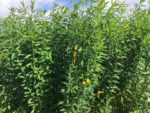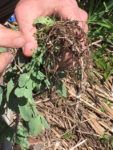The educational materials listed on this page are about No-Till.
No-till farming is a conservation tillage technique where all of a previous crop's residue is left on the soil surface after harvest. No-till systems are usually managed using specific tools—a conservation planter for row crops or a no-till drill for more narrowly seeded crops. Crop residue on the soil surface helps improve soil health by providing protection against soil erosion, temperature extremes and water evaporation, and adding soil organic matter. If converting to no-till from a traditional tillage system, producers may start with a less drastic change such as strip-, ridge- or zone-till to help increase the soil’s organic matter. No-till farmers have to be more aware of weed control, compaction prevention and seed placement than conventional farmers. Cover crops are often turned under in conventional tillage systems, but adding cover crops to a no-till system improves soil health, provides nutrients and increases soil moisture. Using no-till in organic systems is not as common because residue on the soil surface increases weed pressure. Organic producers can use a roller crimper to flatten cover crops, which creates a mulch that will help suppress weeds. Learn about the impact that tillage has on your soils and various soil conservation options in the Reducing Tillage chapter of Building Soils for Better Crops.
Showing 1-2 of 2 results

Economics of Cover Crops II (Part 2): Benefits of Cover Crops and No-Till Vegetable Production in North Alabama
While the benefits of cover crops are similar regardless of cash crop, there are a number of benefits that are particularly important to vegetable producers. The main benefits of cover crops in vegetable production include increased organic matter; additional N through the use of legumes; suppressing disease, nematodes, and weeds; reducing soil erosion; providing habitat for beneficial insects; and improving soil tilth.

Soil Biology: Cover Crops and Disease Suppression
Cover crops provide several benefits to soil health such as improving soil structure, reducing the need for synthetic chemicals by decreasing weed biomass, increasing soil organic matter, contributing nutrients to the soil, retaining soil moisture, and decreasing soil erosion. In addition, the integration of cover crops into crop production often leads to soils that are suppressive to plant diseases (i.e. have less potential for disease development).